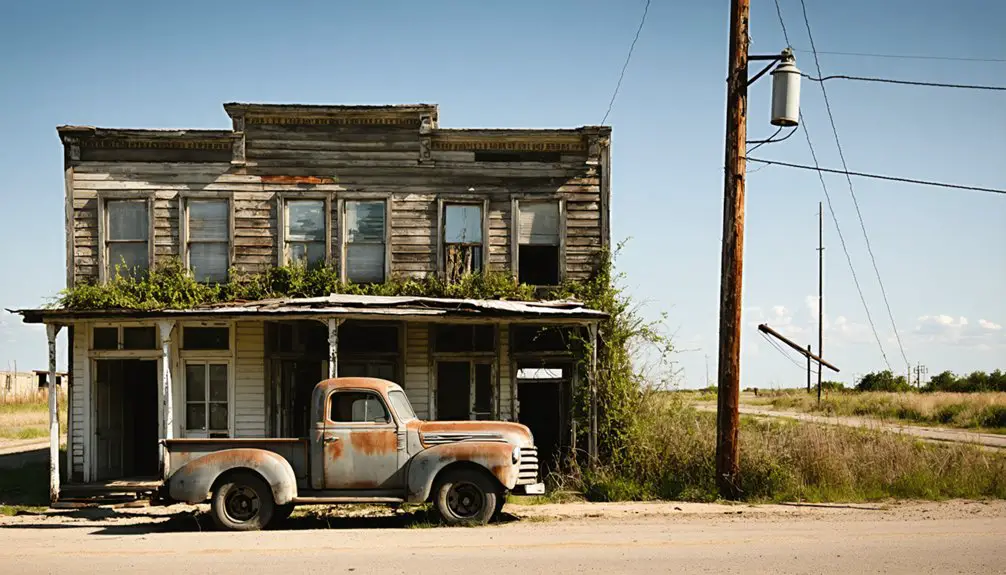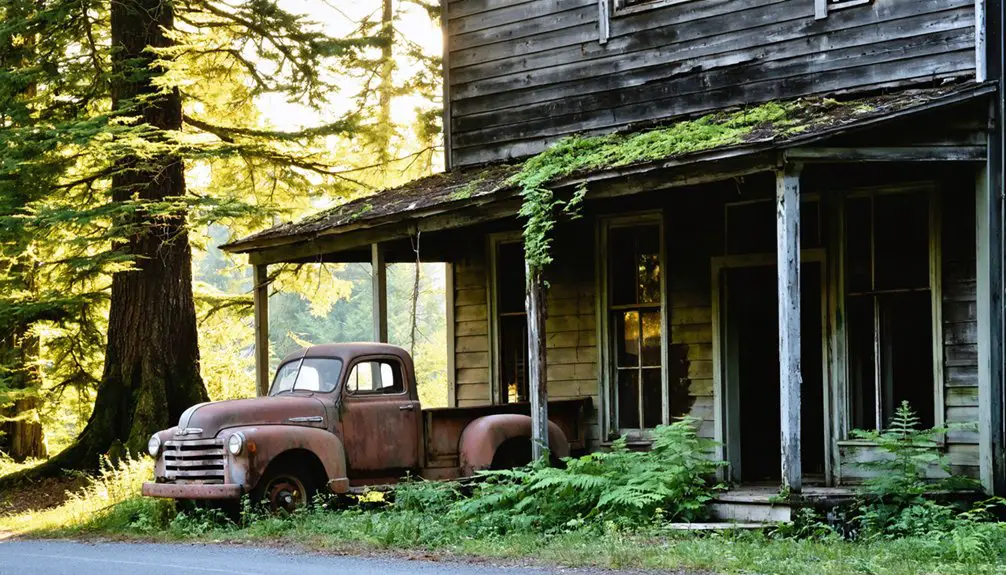You’ll find Cascadia along the historic Santiam Wagon Road, where it flourished as a mining town in the 1890s. The site gained prominence for its therapeutic mineral springs at Mountain House lodge and the profitable California Mine, which yielded ore worth $500 per ton during peak years. Today, you can explore the weathered wooden structures, hand-laid stone foundations, and mining equipment that tell the story of Oregon’s frontier spirit and determination. The town’s preserved features hold countless untold tales of the Old West.
Key Takeaways
- Cascadia originated as a vital stop on the Santiam Wagon Road, featuring the Mountain House lodge known for therapeutic mineral waters.
- The town flourished during the 1898-1905 gold mining boom, with the California Mine producing ore worth $500 per ton.
- Local architecture showcased frontier construction with steep-pitched roofs, wraparound porches, and stone foundations built from regional materials.
- Mining operations utilized stamp mills, water-powered concentrators, and over 1,000 feet of tunnels for gold extraction.
- The town’s decline followed the depletion of mining and timber resources, with the post office closure marking its transformation into a ghost town.
Origins and Early Settlement History
While pioneers traversed the rugged Oregon territory in the mid-1800s, Cascadia emerged as an important stage stop along the Santiam Wagon Road, offering weary travelers a respite at its mineral springs.
You’ll find that early travelers often stopped at the Mountain House lodge, where they’d discover the therapeutic mineral waters that would later transform Cascadia into a popular health resort. The John Thompson family was among the first to recognize the springs’ value, using them for personal consumption. Grandmother Lettie Thompson found employment at the Mountain House during the summer of 1895.
As more pioneers passed through, you’d see the gradual development of inns and services catering to wagon traffic. Though the toll system at the local gate sparked some resistance from budget-conscious settlers, Cascadia’s position near essential transportation routes secured its place as a significant waypoint in Oregon’s pioneer history. The area’s geological instability was evident in the ghost forests that dotted the coastline, where ancient cedar trees had been killed by saltwater flooding.
Mining Operations and Economic Peak
You’ll find that Cascadia’s mining operations relied heavily on stamp mills and water-powered concentrators to process gold-bearing ore containing pyrite, sphalerite, and other sulfides found in northwest-trending quartz veins.
The district’s peak production years between 1898 and 1905 saw ore values reaching up to $500 per ton at the California Mine in the Cable Cove area. Jeremiah Driggs initiated the area’s first mining activity by filing a gold claim in 1863, setting off a wave of prospecting that would follow.
Miners extensively developed the region through tunneling and shaft work, creating over 1,000 feet of accessible passages to extract precious metals, though many ventures ultimately proved unprofitable due to complex ore mineralogy and challenging terrain. The nearby Sumpter dredge field became the largest in Oregon by 1912, significantly impacting regional mining operations.
Mining Equipment and Methods
As Cascadia’s mining operations expanded beyond simple prospecting, the evolution of equipment and methods marked distinct phases in the town’s development.
You’d find miners initially working with basic hand tools, panning for gold in streambeds before advancing to more sophisticated mining innovations like steam-powered drills and stamp mills. Modern operator performance management helped maximize efficiency and reduce costly operational gaps. Similar to how multibeam sonar systems revolutionized methane seep detection, technological advances transformed mining capabilities.
The equipment legacy of Cascadia showcases the shift from simple placer mining to complex hard rock operations, where horse-drawn hoists and steam engines revolutionized ore extraction and processing.
- The rhythmic pounding of stamp mills echoed through the valley, crushing ore day and night in pursuit of precious metals
- Steam whistles pierced the mountain air, signaling the dawn of mechanized mining in this rugged frontier
- Weathered mining equipment still dots the landscape, silent sentinels of Cascadia’s golden age
Peak Production Years 1898-1905
The seven years between 1898 and 1905 marked Cascadia’s golden age of mining, sparked by the discovery of the Oregon King vein in 1898.
During this mining boom, companies like Rocky Gulch Mining Co. pulled in up to $100 in gold per day, while some quartz ledges assayed at an impressive $25 per ton or higher.
The economic impact rippled through the region as outside investors poured capital into expanding operations.
The town swiftly developed with various businesses including a general store and saloon.
You’d have seen new infrastructure cropping up everywhere – deep tunnels reaching 350 feet, reduction mills processing ore, and hydraulic mining operations transforming the landscape.
The town itself grew rapidly, gaining a post office and other essential services.
Workers flooded in to support the expanding operations, though production often fluctuated based on water availability and ore quality at different depths.
The mild climate and low altitude of Southern Oregon’s valleys contributed significantly to the region’s year-round mining capabilities.
Mineral Types and Deposits
While gold dominated Cascadia’s mining operations, the area’s mineral wealth extended beyond precious metals to include native copper, manganese oxides, and trace amounts of silver and zinc. Collectors today must follow BLM daily limits when exploring historic mining areas.
You’ll find most deposits occurred within quartz veins and brecciated zones, evidence of the region’s volcanic activity and hydrothermal alteration. During mineral exploration, miners discovered that the ore bodies were relatively small but sometimes rich, with deposit valuation reaching up to $500 per ton in select veins. Similar to the famous Carlin-type deposits in Nevada, the area’s geological formations suggested potential for further discoveries.
- The freedom to prospect led early miners to uncover hidden treasures in volcanic host rocks
- Each vein told a story of nature’s raw power, formed by ancient hydrothermal forces
- The district’s untapped potential still beckons to modern-day explorers seeking their fortune
The Town’s Architectural Legacy
When you explore Cascadia’s remaining structures today, you’ll find buildings constructed primarily from locally-sourced timber and stone, reflecting the practical frontier construction methods of late 19th-century Oregon.
The architectural design favored practical features like steep-pitched roofs to handle heavy rainfall, wraparound porches for the resort’s social gatherings, and sturdy foundations that have helped several structures survive to the present day.
These preserved features, including original resort facilities and stage stop buildings, offer tangible evidence of Cascadia’s dual role as both a transportation hub and a popular mineral springs destination.
Building Materials and Methods
Local timber and native stone formed the backbone of Cascadia’s architectural legacy, reflecting both the town’s frontier resourcefulness and its deep connection to Oregon’s lumber industry.
You’ll find that timber sourcing relied heavily on the surrounding forests, with builders using hand-hewn beams before shifting to milled lumber. Construction techniques like balloon framing dominated, while foundations were crafted from local stone set directly on compacted earth.
In response to the damp forest environment, builders extended roof overhangs and oriented structures to maximize natural heating and cooling.
- The weathered wooden frames still stand as silent witnesses to the pioneering spirit of early Oregon settlers
- Each hand-laid stone foundation tells a story of determination and self-reliance
- The simple yet ingenious construction methods remind us of a time when freedom meant building your future with your own hands
Structural Design Elements
Despite their frontier origins, Cascadia’s buildings exhibited thoughtful structural design elements that balanced practicality with period aesthetics.
You’ll notice structural adaptations like elevated foundations to combat flooding and steep roof pitches designed to handle the region’s heavy rainfall. The buildings’ natural ventilation systems were perfectly suited for the humid coastal climate, while gabled roofs and false fronts created an illusion of permanence in this temporary boom town.
Building functionality was paramount, with structures strategically placed throughout the grid-like layout. Main commercial buildings featured covered walkways and porches that encouraged community interaction, while industrial facilities were positioned on the outskirts for safety.
Simple window and door surrounds reflected the town’s utilitarian nature, though you might spot occasional decorative brackets on prominent buildings.
Remaining Historic Features
Today’s visitors to Cascadia can still explore several original wooden structures that stand as evidence to the town’s frontier heritage.
These architectural remnants showcase the region’s reliance on local timber and simple construction methods. You’ll find weathered false fronts along former commercial buildings, while stone foundations hint at the town’s more substantial structures from its heyday.
Cultural preservation efforts have helped maintain these authentic features for future generations.
- Walk among the ghostly wooden storefronts that once bustled with miners and loggers seeking their fortune in Oregon’s wilderness
- Discover original stone foundations and chimneys that mark where pioneering families made their homes
- Stand before the historic cemetery, where weathered headstones tell silent stories of Cascadia’s earliest settlers
Natural Forces and Geological Impact
The powerful Cascadia Subduction Zone dominates the geological landscape around Cascadia, where three tectonic plates slide beneath North America’s continental plate.
You’ll find evidence of natural disasters and geological formations throughout the region, from ancient ghost forests to dramatic coastal features shaped by tectonic forces.
When you explore the area, you’ll notice the lasting impact of the massive 1700 earthquake that dropped the coastline by up to 12 meters. The violent shaking and subsequent tsunami killed coastal forests instantly, leaving behind preserved stumps you can still see during low tide.
Today, the landscape continues to transform through ongoing geological processes – the land gradually uplifts at three feet per thousand years while wave erosion sculpts the rocky shore, creating tide pools and exposing fault lines in coastal outcrops.
The Path to Abandonment

Once miners discovered precious minerals in 1898, Cascadia quickly transformed from untamed wilderness into a bustling frontier settlement.
You’ll find that the town’s community decline accelerated as both mining and timber resources became depleted, leaving workers with few options for survival. Economic factors hit hard – without railways or major roads to enable trade, the isolated town couldn’t attract new industries to replace the failing ones.
- Families who’d built their dreams here were forced to abandon their homes and seek opportunities in urban centers.
- The post office’s closure marked the death knell for this once-proud frontier community.
- Nature slowly reclaimed the land as buildings crumbled and streets emptied, leaving only memories of Cascadia’s glory days.
As essential services vanished and infrastructure deteriorated, even the most resilient residents eventually surrendered to the inevitable exodus.
Cultural Heritage and Historical Significance
During Oregon’s western expansion period, Cascadia emerged as a pivotal example of frontier resourcefulness and ambition, reflecting broader patterns of 19th-century mining settlements across the Pacific Northwest.
Cascadia stood as a testament to pioneer ingenuity, mirroring countless mining towns that shaped the Pacific Northwest’s rugged frontier landscape.
You’ll find that Cascadia’s cultural preservation efforts have maintained key structures and landmarks, particularly its post office and cemetery sites, which serve as windows into the region’s pioneering spirit.
The town’s archaeological remains tell a compelling story of community identity, shaped by the rugged individualism of miners and settlers who called this place home.
While the population was largely transient and male-dominated, the cemetery grounds suggest deeper community bonds formed during Cascadia’s peak years.
Today, these preserved remnants offer essential insights into Oregon’s mining heritage and the determined spirits who shaped the American West.
Modern-Day Ghost Town Tourism

Today, visitors flock to Cascadia’s haunting remnants, drawn by its authentic glimpse into Oregon’s mining era and relatively intact historical structures.
Ghost town tourism here attracts diverse visitor demographics, from adventurous young adults to history enthusiasts and photographers. You’ll find the site’s popularity peaks during warmer months, when guided tours and educational programs enhance your exploration of this preserved slice of the Old West.
- Feel the whispers of the past as you walk among weathered buildings that once bustled with life
- Experience the raw authenticity of untamed wilderness reclaiming human settlement
- Discover hidden stories through artifacts and architectural remnants that time forgot
Modern preservation efforts blend technology with tradition, offering virtual tours and interactive apps while maintaining the site’s historical integrity.
Local businesses in surrounding communities support your journey with lodging, dining, and transportation services.
Frequently Asked Questions
Are There Any Reported Paranormal Activities or Ghost Sightings in Cascadia?
While you might expect ghostly encounters in an old mining town, there aren’t any documented spectral legends or verified paranormal activities in Cascadia. You’re free to explore, but supernatural sightings remain unconfirmed.
What Happened to the Personal Belongings Left Behind by Former Residents?
You’ll find abandoned treasures gradually succumbed to weather, vandalism, and scavenging. Lost memories remain in deteriorating buildings, while some belongings ended up in local museums or were taken by opportunistic visitors.
Can Visitors Legally Explore and Metal Detect in Cascadia Today?
You can legally explore within Cascadia State Park boundaries, but metal detecting requires special permits and likely isn’t allowed due to strict visitor regulations protecting historic artifacts under state park laws.
Were There Any Notable Crimes or Mysterious Disappearances in Cascadia’s History?
You’ll find one of Oregon’s darkest unsolved mysteries tied to Cascadia – serial killer John Ackroyd committed multiple historical crimes along Highway 20, including murders and disappearances between the 1970s-1990s.
Did Any Famous Individuals or Historical Figures Ever Visit Cascadia?
While millions passed through the Pacific Northwest, you won’t find any famous visitors or documented historical connections to Cascadia. The small mining camp mainly attracted local prospectors and settlers, not notable figures.
References
- https://www.e-education.psu.edu/earth107/node/1614
- https://www.youtube.com/watch?v=8j8u3EWaStU
- https://kids.kiddle.co/List_of_ghost_towns_in_Oregon
- https://en.wikipedia.org/wiki/List_of_ghost_towns_in_Oregon
- https://storymaps.arcgis.com/stories/c6e7c95818d046e69fd6a66a655821c1
- http://www.oregonpioneers.com/Cascadia_Story.htm
- https://en.wikipedia.org/wiki/Neskowin_Ghost_Forest
- https://westernmininghistory.com/5738/a-collection-of-oregon-mining-photos/
- https://www.oregonlegislature.gov/citizen_engagement/Reports/DOGAMI_9-14-06_Report.pdf
- https://www.oregon.gov/dogami/milo/archive/MiningDistricts/LinnCounty/QuartzvilleDistrict/QuartzvilleGeneralReport/QuartzvilleGeneralReport.pdf



